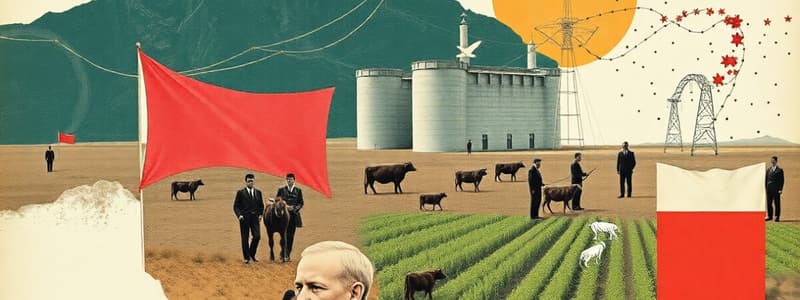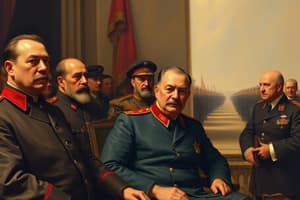Podcast
Questions and Answers
What was the main reason for the decline in Soviet economic growth rates from the 1950s to the 1970s?
What was the main reason for the decline in Soviet economic growth rates from the 1950s to the 1970s?
- The decrease in oil production after the global oil crisis of the 1970s.
- The implementation of Kosygin's economic reforms.
- The failure to achieve 'intensive growth' due to inefficiencies in central planning. (correct)
- The increasing burden of military spending following Brezhnev's policies.
Which of the following was NOT a characteristic of the Soviet economy under Brezhnev?
Which of the following was NOT a characteristic of the Soviet economy under Brezhnev?
- The acceptance and toleration of a ‘black market’ for goods and services.
- A focus on increasing the quantity and quality of consumer goods produced.
- A significant increase in agricultural production through the implementation of Khrushchev's ‘Virgin Lands’ scheme. (correct)
- A reliance on importing grain from the West to maintain low food prices.
Which of these reforms were introduced during the early years of Brezhnev's leadership?
Which of these reforms were introduced during the early years of Brezhnev's leadership?
- A return to five-year plans and a focus on heavy industry. (correct)
- A complete dismantling of the central planning system and a move towards a market economy.
- A significant restructuring of the collective farm system and a shift towards private ownership.
- An increase in consumer goods production and a focus on improving quality.
What was the primary goal of Kosygin's economic reforms?
What was the primary goal of Kosygin's economic reforms?
Which of the following was a direct consequence of Brezhnev's focus on military parity with the USA?
Which of the following was a direct consequence of Brezhnev's focus on military parity with the USA?
Which of Andropov's three campaigns aimed to address the issue of corruption in the Soviet system?
Which of Andropov's three campaigns aimed to address the issue of corruption in the Soviet system?
What was the main reason behind Breznev's acceptance of the ‘black market’ in the Soviet economy?
What was the main reason behind Breznev's acceptance of the ‘black market’ in the Soviet economy?
Why did Andropov's reforms fail to stop the economic decline in the Soviet Union?
Why did Andropov's reforms fail to stop the economic decline in the Soviet Union?
Which of the following accurately describes the Soviet economy’s performance during the 1970s?
Which of the following accurately describes the Soviet economy’s performance during the 1970s?
What was the main reason for the relative decrease in Soviet economic growth rates compared to the US economy during the 1950s and 1960s?
What was the main reason for the relative decrease in Soviet economic growth rates compared to the US economy during the 1950s and 1960s?
What was a significant action taken by Khrushchev regarding collective farms to improve production?
What was a significant action taken by Khrushchev regarding collective farms to improve production?
What was the main goal of the Virgin Lands Scheme launched by Khrushchev?
What was the main goal of the Virgin Lands Scheme launched by Khrushchev?
What was the consequence of the Corn Campaign initiated by Khrushchev?
What was the consequence of the Corn Campaign initiated by Khrushchev?
Between 1954-1959, how did agricultural investment change in the Soviet budget?
Between 1954-1959, how did agricultural investment change in the Soviet budget?
What result did the changes in the government’s relationship with collective farms primarily lead to?
What result did the changes in the government’s relationship with collective farms primarily lead to?
What problem did Soviet farms face in comparison to US farms during the Corn Campaign?
What problem did Soviet farms face in comparison to US farms during the Corn Campaign?
What was the increase in the number of tractors available by 1955 due to Khrushchev's investments?
What was the increase in the number of tractors available by 1955 due to Khrushchev's investments?
What was one of the primary focuses of the Corn Campaign?
What was one of the primary focuses of the Corn Campaign?
What was the initial result of the Virgin Lands Scheme between 1953 and 1958?
What was the initial result of the Virgin Lands Scheme between 1953 and 1958?
What was a critical limitation of Soviet agriculture highlighted during the Corn Campaign?
What was a critical limitation of Soviet agriculture highlighted during the Corn Campaign?
What was the percentage increase in agricultural production overall by 1964 compared to 1958?
What was the percentage increase in agricultural production overall by 1964 compared to 1958?
What was one major drawback of the Virgin Lands Scheme?
What was one major drawback of the Virgin Lands Scheme?
What was Khrushchev’s expectation for food production by 1960?
What was Khrushchev’s expectation for food production by 1960?
Which of the following was a consequence of Khrushchev's central planning in agriculture?
Which of the following was a consequence of Khrushchev's central planning in agriculture?
What did the 7 Year Plan aim to boost primarily?
What did the 7 Year Plan aim to boost primarily?
Which statement accurately reflects Khrushchev's approach to agricultural policies?
Which statement accurately reflects Khrushchev's approach to agricultural policies?
What significant change occurred in military spending from 1955 to 1958?
What significant change occurred in military spending from 1955 to 1958?
What was one of the main issues with the introduction of the Sovnarkhoz reforms?
What was one of the main issues with the introduction of the Sovnarkhoz reforms?
What was the intended outcome of increasing chemical production under Khrushchev's policies?
What was the intended outcome of increasing chemical production under Khrushchev's policies?
What indicates a failure in Khrushchev's agricultural policies?
What indicates a failure in Khrushchev's agricultural policies?
Flashcards
Virgin Lands Scheme
Virgin Lands Scheme
Khrushchev's policy to increase agricultural production by converting unused land in the Northern Caucasus, Kazakhstan, and Western Siberia into new farms.
Productivity
Productivity
The amount of a product that can be produced per unit of input, such as land or labor.
Opportunity Cost
Opportunity Cost
The idea that a decision to produce more of one good means producing less of something else.
Corn Campaign
Corn Campaign
Signup and view all the flashcards
Quota
Quota
Signup and view all the flashcards
Incentive Prices
Incentive Prices
Signup and view all the flashcards
Farm Equipment
Farm Equipment
Signup and view all the flashcards
Fertilizers
Fertilizers
Signup and view all the flashcards
Surplus
Surplus
Signup and view all the flashcards
Improved Incentives
Improved Incentives
Signup and view all the flashcards
Production over consumption
Production over consumption
Signup and view all the flashcards
Kosygin Reforms
Kosygin Reforms
Signup and view all the flashcards
Post-Khrushchev Era
Post-Khrushchev Era
Signup and view all the flashcards
Soviet Economic Decline
Soviet Economic Decline
Signup and view all the flashcards
Military Parity
Military Parity
Signup and view all the flashcards
Developed Socialism
Developed Socialism
Signup and view all the flashcards
Second Economy
Second Economy
Signup and view all the flashcards
Andropov's Reforms
Andropov's Reforms
Signup and view all the flashcards
Intensive Growth
Intensive Growth
Signup and view all the flashcards
Oil Price Boom
Oil Price Boom
Signup and view all the flashcards
Soviet Agriculture Inefficiency
Soviet Agriculture Inefficiency
Signup and view all the flashcards
Virgin Lands Scheme Failure
Virgin Lands Scheme Failure
Signup and view all the flashcards
Khrushchev's Agricultural Policies
Khrushchev's Agricultural Policies
Signup and view all the flashcards
Khrushchev's Military Spending
Khrushchev's Military Spending
Signup and view all the flashcards
Seven-Year Plan (1959)
Seven-Year Plan (1959)
Signup and view all the flashcards
Seven-Year Plan (1959) Success
Seven-Year Plan (1959) Success
Signup and view all the flashcards
Issues with the Seven-Year Plan (1959)
Issues with the Seven-Year Plan (1959)
Signup and view all the flashcards
Soviet Economic System and Consumer Goods
Soviet Economic System and Consumer Goods
Signup and view all the flashcards
Khrushchev's Agricultural Goals and Soviet System
Khrushchev's Agricultural Goals and Soviet System
Signup and view all the flashcards
Study Notes
Economic Priorities 1953-1985
- Khrushchev's agricultural reforms (1953-1964) aimed to boost production.
- Incentive improvements: Reduced quotas, higher prices, leading to a 250% rise in farm incomes (1952-1956).
- Resource investment: Increased fertilizer and tractor production, 30% tractor, 40% fertilizer increase (1955).
- Virgin Lands Scheme: Ambitious plan to cultivate new lands in the Northern Caucasus, Kazakhstan, and Western Siberia. Agricultural investment tripled (1954-1959), from under 3% to 12.8% of the budget.
- Total area sown: Increased significantly (18.2 million hectares in 1953 to 97.4 million hectares in 1964).
Corn Campaign
- Khrushchev encouraged maize production in the Ukraine.
- Failure: Soviet farms produced only 50% of the corn per hectare compared to US farms due to climate, lower productivity, and inferior equipment.
- Reduced animal feed production by 30%.
Agricultural Successes (1953-1958)
- Significant increases in grain harvests, meat, and milk production.
- 35.3% overall agricultural growth.
- Increased food availability and farm worker income (400%).
- Allowed Khrushchev to consolidate his position and pursue ambitious goals.
Agricultural Failures (1954-1964)
- Inefficiencies in Soviet agriculture persisted.
- Costs of the Virgin Lands Scheme.
- Labour-intensive nature of Soviet agriculture (54-44% of the population).
- Declining harvests after initial success (1960-1964), 15% higher production than 1958.
Issues with Khrushchev's Policies
- Ineffective centrally directed campaigns (e.g., Corn Campaign).
- Reform-related confusion in agricultural ministries.
- Inadequate storage and waste of produce.
Industrial Modernisation
Military Spending
- Khrushchev initially decreased military spending (1955-1958), then it rose again.
- Military spending reached 11% of GDP in 1964.
- Growth reduced as military spending grew.
Seven-Year Plan (1959)
- Goal: Boost agricultural and consumer goods production.
- Focus: Chemical production, hoped to improve fertilizer, increase crop yield and consumer goods.
- Success: Increased chemical and consumer goods production but fell short of targets.
Problems with the Seven-Year Plan
- Frequent economic reorganizations (e.g., 1957 Sovnarkhoz reforms – decentralized power, disrupted coordination, 1962 split the party to further increase chaos). This lead to inconsistent, short-lived plans.
- Unrealistic targets.
Post-1964 Economic Reforms
- Restoration (after Khrushchev):
- Return to 5-Year plans.
- Less ambitious consumer goods goals compared to Khrushchev.
Kosygin Reforms (1968)
- Goal: Improve efficiency by granting more power to factory managers and linking success to profits.
- Outcome: Reforms ended in August 1968 before going into effect, as reforms in Czechoslovakia sparked rebellion.
Brezhnev's Policies
-
Increased military spending to achieve nuclear parity with the US
-
Developed Socialism:
- Abandoned Khrushchev's promise of communism by 1980,
- Emphasized job security and low prices, achieved through grain imports from the West.
- Accepted the black market ("necessary evil").
Andropov's Reforms (1982-1984)
- Goal: Address economic problems.
- Campaigns: Anti-corruption, anti-alcohol, "Operation Trawl".
- Impact: Reduced Vodka consumption but failed to fix underlying issues.
Declining Growth
- Soviet economy's growth rate declined significantly after 1960s.
- Causes: Inefficiencies in central planning, inability to achieve "intensive growth" (growth based on efficiency improvements).
Impact of Oil Prices
- 1970s oil price increases masked deeper problems.
- Allowed imports and maintained living standards initially.
Overall Soviet Economy (1964-1985)
- Minimal reforms, lower expectations.
- Continued reliance on central planning and collectivisation.
Studying That Suits You
Use AI to generate personalized quizzes and flashcards to suit your learning preferences.




